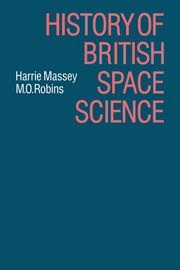Book contents
- Frontmatter
- Contents
- Glossary of abbreviations in text and annexes
- Glossary of abbreviations in appendices
- Preface
- 1 The scientific background
- 2 The technical background
- 3 The initiation of the Skylark rocket programme – the IGY and artificial satellites
- 4 Post-IGY developments – NASA – COSPAR – British National Committee for Space Research – British satellite experiments
- 5 The Ariel programme
- 6 The European Space Research Organization
- 7 Commonwealth co-operation in space reseach
- 8 Smaller rockets for scientific purposes – Skua and Petrel
- 9 Attitude controlled Skylark rockets
- 10 The Trend Committee and the Science Research Council
- 11 The transformation of ESRO into ESA
- 12 The Space Science Committee for Europe
- 13 Scientific studies by British space scientists – figure of the earth and the neutral atmosphere
- 14 Scientific studies by British space scientists – the ionosphere, the magnetosphere and cosmic rays
- 15 The contribution from British space scientists to astronomy
- 16 Concluding remarks
- Appendices
- Annexes
- Notes
- Index
15 - The contribution from British space scientists to astronomy
Published online by Cambridge University Press: 05 February 2012
- Frontmatter
- Contents
- Glossary of abbreviations in text and annexes
- Glossary of abbreviations in appendices
- Preface
- 1 The scientific background
- 2 The technical background
- 3 The initiation of the Skylark rocket programme – the IGY and artificial satellites
- 4 Post-IGY developments – NASA – COSPAR – British National Committee for Space Research – British satellite experiments
- 5 The Ariel programme
- 6 The European Space Research Organization
- 7 Commonwealth co-operation in space reseach
- 8 Smaller rockets for scientific purposes – Skua and Petrel
- 9 Attitude controlled Skylark rockets
- 10 The Trend Committee and the Science Research Council
- 11 The transformation of ESRO into ESA
- 12 The Space Science Committee for Europe
- 13 Scientific studies by British space scientists – figure of the earth and the neutral atmosphere
- 14 Scientific studies by British space scientists – the ionosphere, the magnetosphere and cosmic rays
- 15 The contribution from British space scientists to astronomy
- 16 Concluding remarks
- Appendices
- Annexes
- Notes
- Index
Summary
British space scientists have devoted a great deal of attention to research in those branches of astronomy which became practicable only after the availability of space vehicles. We discuss here especially their major contributions to ultra-violet and X-ray astronomy both solar and cosmic. Most of the British work in γ-ray astronomy and in infra-red astronomy (outside the atmospheric window) has been carried out very effectively using balloons and so does not fall within the scope of the present account. The very recent successful launching and operation of the infra-red astronomy satellite IRAS points the way to a strong involvement of British space scientists in infra-red astronomy also.
We begin by discussing first solar ultra-violet and X-ray astronomy, then cosmic ultra-violet astronomy followed by cosmic X-ray astronomy and brief sections on γ-ray and infra-red astronomy.
Solar X-ray and ultra-violet astronomy
The first X-rays entering the atmosphere from an external source were observed by T.R. Burnight in 1948 who exposed Schumann plates with thin beryllium filters, carried to an altitude of 96 km in an Aerobee rocket. On recovery and development, the plates were found to be blackened, showing that they had been exposed to radiation capable of penetrating the beryllium. The first quantitative measurements of X-rays, which clearly originated in the sun, were made by H. Friedman, H. Lichtman and E.T. Byram a year later using a photon counter flown in a V2 rocket.
- Type
- Chapter
- Information
- History of British Space Science , pp. 339 - 389Publisher: Cambridge University PressPrint publication year: 1986



